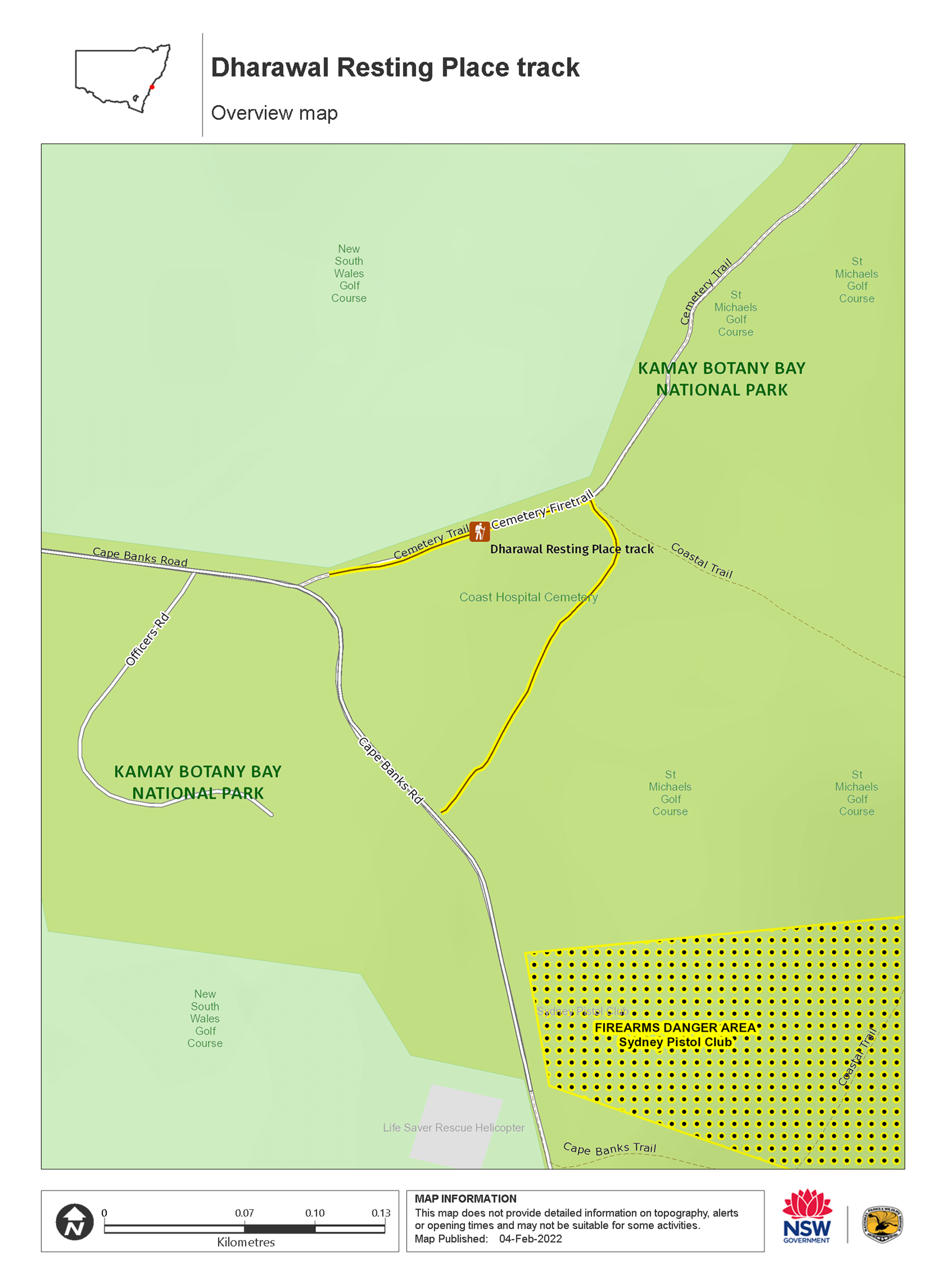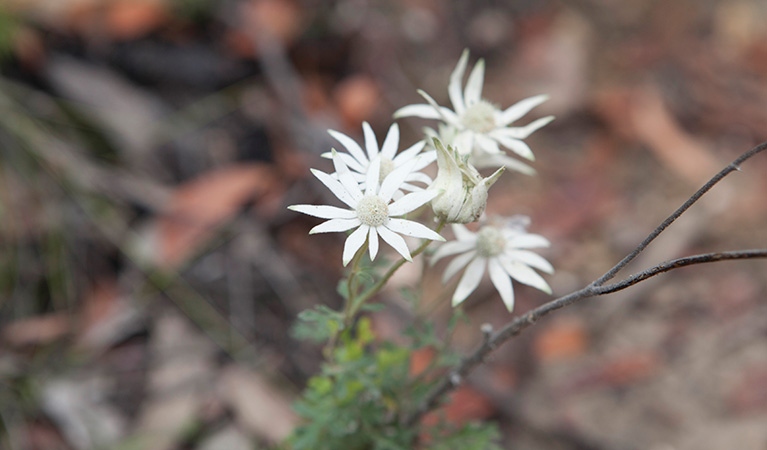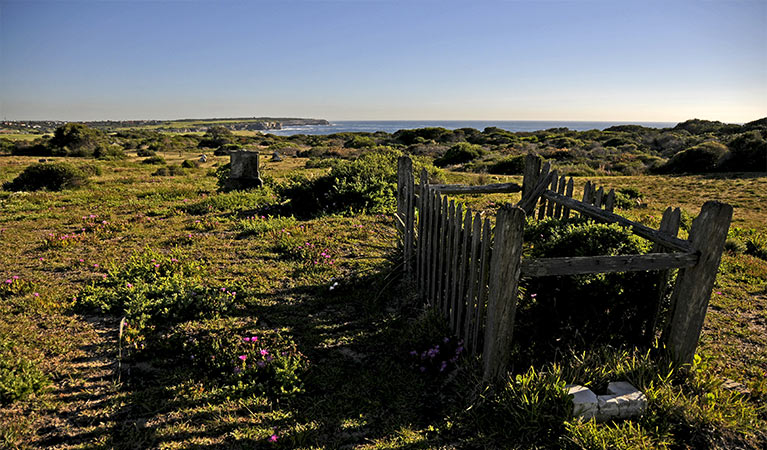Dharawal Resting Place track
La Perouse area in Kamay Botany Bay National Park
Open, check current alerts
Overview
Walk the short track to Dharawal Resting Place to discover this important La Perouse Aboriginal site, that’s also steeped in Sydney’s colonial history.
- Accessibility
- Medium
- Distance
- 0.2km one-way
- Time suggested
- 10min
- Grade
- Grade 3
- What to
bring - Drinking water, hat, sunscreen, snacks, sturdy shoes
- Please note
- Dharawal Resting Place is a designated Aboriginal site, that holds special cultural significance to the Dharawal People. Please respect this important site.
- You can combine this walk with Cape Banks walking track. Cemetery trail is around 1km north-east of Cape Banks headland via the coastal fire trail and Cape Banks Road.
Discover a sense of place and cultural heritage as you explore the Dharawal Resting Place walking track, in Kamay Botany National Park. Located on a grassy slope near Cape Banks headland, this 200m walking track is short on distance but long on cultural significance.
A designated Aboriginal site, this area is an important site to the Dharawal People. In 2002, 2005 and 2018 Aboriginal ancestral remains were reburied here, in the Dharawal Resting Place, part of the Coast Hospital Cemetery. It continues to be a special place to the Aboriginal community.
You’ll also find crumbling tombstones in the cemetery—a window into lives lived and lost during colonial times. From the late 1800s to the early 1900s, the Coast Hospital Cemetery was Sydney’s main burial ground for people who died of infectious diseases.
As you follow the old stone path through the area, take time to read the headstones and information boards to learn more about the Aboriginal and colonial heritage. Don’t miss the Dharawal Resting Place Monument on the site’s east side.
If you’re after a longer walk try nearby Cape Banks or Henry Head walking tracks. History buffs can head to Bare Island Fort or La Perouse Museum.
Map

Map legend

Local alerts
For the latest updates on fires, closures and other alerts in this area, see https://www.nationalparks.nsw.gov.au/things-to-do/walking-tracks/dharawal-resting-place-track/local-alerts
General enquiries
- National Parks Contact Centre
- 7am to 7pm daily
- 1300 072 757 (13000 PARKS) for the cost of a local call within Australia excluding mobiles
- parks.info@environment.nsw.gov.au
Park info
- in the La Perouse area of Kamay Botany Bay National Park in the Sydney and surrounds region
7am–8.30pm November to March.
7am–7.30pm April to October.
La Perouse park entry gate closed to vehicles between 7pm and 5am all year.
Areas may have to close at times due to poor weather or fire danger.
-
There are no park entry fees in La Perouse area but you'll need to pay to tour Bare Island. Park entry fees apply in the Kurnell area of Kamay Botany Bay National Park, only.
Buy annual pass.
Visitor info
All the practical information you need to know about Dharawal Resting Place track.
Track grading
Features of this track
Distance
0.2km one-way
Time
10min
Quality of markings
Clearly sign posted
Experience required
No experience required
Gradient
Gentle hills
Steps
No steps
Quality of path
Formed track, some obstacles: The track is 3m-wide and begins as hard-packed ground along Cemetery fire trail before becoming grass as it goes through the cemetery.
Other barriers
Gates: There's a locked steel pipe swing gate at the start of Cemetery fire trail. The gate has a gap of around 1m on the side for pedestrians.
Getting there and parking
Dharawal Resting Place track is in the La Perouse area of Kamay Botany National Park. To get there from Sydney city:
- Drive south along Anzac Parade to La Perouse
- Turn left at the park boundary on to Henry Head Lane, towards the golf course
- Turn left onto Cape Banks Road and follow 1km to the junction with Cemetery trail, where there’s limited parking.
- You can also continue around 350m along Cape Banks Road to the carpark at the helicopter base.
Road quality
- Sealed roads
Vehicle access
- 2WD vehicles
Weather restrictions
- All weather
Parking
- Limited parking is available in designated areas along Cape Banks Road, including at the entry to Cemetery trail.
- You can also park at the helicopter base at the end of Cape Banks Road, then walk 350m back down the road to Cemetery trail. This carpark has 2 accessible parking spaces.
By bike
- You can cycle to La Perouse via Anzac Parade. Then take Henry Head Lane and Cape Banks Road.
- You’ll need to lock and leave your bike at the designated parking areas along Cape Banks Road and walk to the start of this walking track.
By public transport
Take bus L94 or 394 to La Perouse from Circular Quay, Martin Place, or Hyde Park via Maroubra Junction.
Facilities
- The nearest public toilets are available at Cann Park. There are also toilets if you’re visiting the La Perouse Museum.
- There are no bins so please take all rubbish away with you.
Carpark
Maps and downloads
Accessibility
Disability access level - medium
Dharawal Resting Place track is a 3m-wide walk that's mostly flat with some gentle hills.
There are some parts of the walk where you may need assistance:
- The track surface is not sealed - it starts off as hard-packed ground before changing to grass
- There's a locked steel pipe swing gate at the start of Cemetery fire trail. The gap to get around this gate is only 1m wide.
Prohibited
Camping
Cycling
Pets
Pets and domestic animals (other than certified assistance animals) are not permitted. Find out which regional parks allow dog walking and see the pets in parks policy for more information.
Smoking
NSW national parks are no smoking areas.
Learn more
Dharawal Resting Place track is in La Perouse area. Here are just some of the reasons why this park is special:
Aboriginal culture

At the time of the first encounters with Europeans, Aboriginal people of 2 different nations - the Goorawal People and the Gweagal People - were living in the area which now includes Kamay Botany Bay National Park. Over 30 Aboriginal sites have been recorded in the park, including rock art and engravings.
- Blak Markets at Bare Island Visit Blak Markets at La Perouse, to discover the best of Aboriginal culture. There'll be traditional dance performances, arts and craft stalls, weaving and bush tucker.
- Dharawal Resting Place track Walk the short track to Dharawal Resting Place to discover this important La Perouse Aboriginal site, that’s also steeped in Sydney’s colonial history.
Sharing traditional knowledge

The Gamay Rangers have been appointed as ‘honorary rangers’ for Kamay Botany Bay National Park. Part of the Commonwealth Indigenous Ranger Program, which is designed to support Indigenous Australians to protect and conserve land and sea Country, the Gamay Rangers work alongside the NSW National Parks and Wildlife Service. The Gamay team share traditional knowledge and techniques, and are involved in the management of natural and cultural resources, protection of marine wildlife, and operation of the national parks on their cultural areas.
- Blak Markets at Bare Island Visit Blak Markets at La Perouse, to discover the best of Aboriginal culture. There'll be traditional dance performances, arts and craft stalls, weaving and bush tucker.
- Dharawal Resting Place track Walk the short track to Dharawal Resting Place to discover this important La Perouse Aboriginal site, that’s also steeped in Sydney’s colonial history.
Historic heritage

Two of Australia's earliest European explorers landed in Botany Bay here—James Cook in 1770, and the Comte de Laperouse in 1788. Cook's botanists, Joseph Banks and Daniel Solander, first explored Australia's natural world here. After the reports of Cook and Banks, Botany Bay was recommended as a suitable site for settlement. But upon inspection by Captain Arthur Phillip it was found unsuitable as it had no secure fresh water or suitable anchorage. Sydney Cove was set up as the penal colony instead. You can also explore the fascinating history of Bare Island Fort on a guided tour, see World War II military remnants at Henry Head, or learn more at La Perouse Museum.
- Bare Island Fort guided tour Join this guided tour to hear about the unpredictable history of Bare Island Fort at La Perouse. We'll cross a 130-year-old wooden bridge and enter a world of fine engineering and great deception.
- Bound for Botany Bay In 1770, James Cook and his crew aboard the Endeavour were bound for a place he would name ‘Botany Bay’. Their 8-day stay had a dramatic impact on the future of Australia. This Stage 2 (Years 3-4) History excursion explores the first British landing on Australian soil.
- Cape Banks walking track Cape Banks walking track is a beautiful coastal walk in La Perouse with views across Sydney’s Botany Bay. Start at Congwong Beach and take a swim along the way before passing Henry Head. Continue to Cape Banks, a fantastic spot for whale watching.
- Dharawal Resting Place track Walk the short track to Dharawal Resting Place to discover this important La Perouse Aboriginal site, that’s also steeped in Sydney’s colonial history.
- La Perouse Museum Housed in a heritage building at La Perouse in Sydney's south, the La Perouse Museum documents the expedition of French explorer the Comte de Laperouse.
Biodiversity

Much of the park’s unspoilt flora give an idea of the plants that were present pre-1770. A conservation effort to protect and rehabilitate rare and threatened species and ecosystems is underway to preserve this heritage-listed Sydney park. Henry Head walking track leads through the rare eastern suburbs banksia scrub now listed as an endangered ecological species.
- Cape Banks walking track Cape Banks walking track is a beautiful coastal walk in La Perouse with views across Sydney’s Botany Bay. Start at Congwong Beach and take a swim along the way before passing Henry Head. Continue to Cape Banks, a fantastic spot for whale watching.
- Jennifer Street boardwalk Jennifer Street boardwalk is a short, wheelchair-accessible walking track in La Perouse. The smooth, boarded path is popular with all ages looking for an easy weekend walk in Sydney.
Visitor experiences

La Perouse offers a real escape just minutes from the city and close to cafes and public transport. Take a day trip to go bushwalking, whale watching or fishing. Learn more about the early European explorers, and Aboriginal stories, at the fascinating exhibits in La Perouse Museum tell. Enjoy a picnic, cafes and fish ’n’ çhips and watch the sun set over the bay. Keep an eye out for guided tours of Bare Island Fort.
Plants and animals protected in this park
Animals
-

White-bellied sea eagle (Haliaeetus leucogaster)
White-bellied sea eagles can be easily identified by their white tail and dark grey wings. These raptors are often spotted cruising the coastal breezes throughout Australia, and make for some scenic bird watching. Powerful Australian birds of prey, they are known to mate for life, and return each year to the same nest to breed.
Plants
-

Blueberry ash (Elaeocarpus reticulatus)
The blueberry ash is a rainforest shrub which produces blue olive-shaped berries and spectacular bell-shaped flowers, which often appear on the plant together. It is a tall slender shrub or small tree found in rainforest, tall eucalypt forest and coastal bushland in eastern NSW, south-east Queensland and Victoria.
-

Flannel flower (Actinotus helianthi)
The delicate flannel flower is so named because of the soft woolly feel of the plant. Growing in the NSW south coast region, extending to Narrabri in the Central West and up to south-east Queensland, its white or pink flowers bloom all year long, with an extra burst of colour in the spring.
-

Old man banksia (Banksia serrata)
Hardy Australian native plants, old man banksias can be found along the coast, and in the dry sclerophyll forests and sandstone mountain ranges of NSW. With roughened bark and gnarled limbs, they produce a distinctive cylindrical yellow-green banksia flower which blossoms from summer to early autumn.
-

Smooth-barked apple (Angophora costata)
Smooth-barked apple gums, also known as Sydney red gum or rusty gum trees, are Australian native plants found along the NSW coast, and in the Sydney basin and parts of Queensland. Growing to heights of 15-30m, the russet-coloured angophoras shed their bark in spring to reveal spectacular new salmon-coloured bark.

